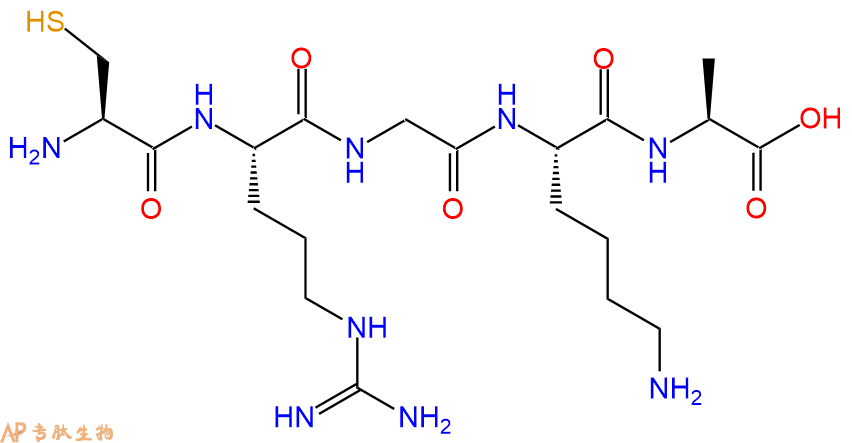400-998-5282
专注多肽 服务科研
400-998-5282
专注多肽 服务科研

| 编号: | 434354 |
| 中文名称: | CRGKA, Giardia Variable Surface Proteins Conserved |
| 英文名: | CRGKA, Giardia Variable Surface Proteins Conserved |
| 单字母: | H2N-CRGKA-OH |
| 三字母: | H2N N端氨基:N-terminal amino group。在肽或多肽链中含有游离a-氨基的氨基酸一端。在表示氨基酸序列时,通常将N端放在肽链的左边。 -Cys半胱氨酸:cysteine。L-半胱氨酸的系统命名为(2R)-氨基-3-巯基丙酸,是编码氨基酸。符号:C,Cys。D-半胱氨酸存在于萤火虫的萤光素酶中。 -ArgL-精氨酸:arginine。系统命名为(2S)-氨基-5-胍基戊酸。在生理条件下带正电荷,为编码氨基酸。是幼小哺乳动物的必需氨基酸。符号:R,Arg。 -Gly甘氨酸:glycine。系统命名为 2-氨基乙酸。是编码氨基酸中没有旋光性的最简单的氨基酸,因具有甜味而得名。符号:G,Gly。 -LysL-赖氨酸:lysine。系统命名为(2S)-6-二氨基已酸。是编码氨基酸中的碱性氨基酸,哺乳动物的必需氨基酸。在蛋白质中的赖氨酸可以被修饰为多种形式的衍生物。符号:K,Lys。 -Ala丙氨酸:alanine。L-丙氨酸的系统命名为(2S)-氨基丙酸,是编码氨基酸,也叫L-α-丙氨酸。符号:A,Ala。D-丙氨酸存在于多种细菌细胞壁的糖肽中。β-丙氨酸是维生素泛酸和辅酶A的组分。 -OHC端羧基:C-terminal carboxyl group。在肽或多肽链中含有游离羧基的氨基酸一端。在表示氨基酸序列时,通常将C端放在肽链的右边。 |
| 氨基酸个数: | 5 |
| 分子式: | C20H39N9O6S1 |
| 平均分子量: | 533.65 |
| 精确分子量: | 533.27 |
| 等电点(PI): | - |
| pH=7.0时的净电荷数: | 3.94 |
| 平均亲水性: | 1.125 |
| 疏水性值: | -0.9 |
| 消光系数: | - |
| 标签: | 含Cys多肽 |





